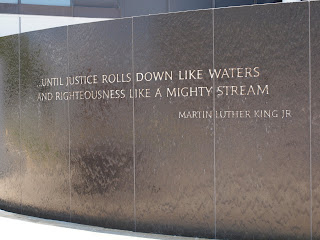On the one hand…Deadly heat. Oppressive history. Confederate flags.
On the other hand…AMAZING food. Beautiful places to visit. Incredible culture.
So as I struggle to decide what I really think about the south, we plod on through. When we arrived in Charleston, I had recently obtained the worst sunburn of my entire life on the beaches of Georgia. We decided to stay at a campsite for the four nights we would be residing in Charleston. We landed ourselves right in the middle of a terrible heat wave during those four days, with suffocating humidity and heat indexes reaching 107 degrees. So with my blazing red back radiating even more heat, I lay miserably in the tent getting two blinks of sleep and fantasizing about laying in a tub of ice (via Little House on the Prairie style). And once again, my travel companion, I’m further learning, can sleep through everything short of a nuclear war.
Groggy, boiling, and in pain we ventured downtown Charleston to do some sightseeing and exploring. We started at the City Market, where local vendors sell their wares, including jewelry, spices, crafts and baskets. The baskets were my favorite, an African American tradition, beautifully crafted by hand with sweet grass. I would have loved to have bought one, but the cheapest one was $20 and was so small it would have been perfect for a Barbie doll to carry. After our browsing we drove closer to the Waterfront Park and took a short walk to “Rainbow Row,” a beautiful line up of colorful historic homes (and probably the most photographed place in Charleston).
We walked a bit further and from this point I thought we might turn around to get the van, but Guy wanted to keep walking and thought the Fort Sumter Center that we had planned on visiting was close by. Not close enough. With my umbrella in hand to shade me from the sun, we plodded through the streets, and I had to stop several times to keep myself from passing out. Guy offered to go get the van several times, but I declined. I’m sure I was an absolute delight to be with. We did finally reach the Fort Sumter Visitor Center, with all of its glorious air conditioning. Fort Sumter is the sight of the beginning of the Civil War, where after decades of growing tension between North and South, the Confederates opened fire on this Federal fort. The actual fort is on an island, and you have to pay for a boat trip/tour to reach it. We opted to view it from afar, and look at the info in the Center instead. After looking at the Center, I took Guy up on his offer to go retrieve the van and pick me up. That would have been the end of me, especially considering I FURTHER burned the lower portion of my back, since the umbrella didn’t fully protect me! Oh sweet misery.
The next day I requested that I stay out of the sun completely, and find place with air conditioning. After seeing a movie, we grabbed some lunch. As we sat there, my heart was racing out of my chest, I was freezing, started shaking terribly with the chills and thought I was going to pass out. Heat exhaustion. My body just couldn’t take it anymore. I was pretty scared for awhile. I think Guy was too. Guy practically started pouring liquids down my throat, and luckily after many hours of doing this, I started to feel as though I didn’t need to go to urgent care. I don’t typically do well with heat, but double sunburn on top of everything, plus sleeping in a tent every night with no air condition = misery.
Monday was the day we had planned to visit a plantation, since we had actually bought tickets in advance. I was very intrigued to visit a plantation, considering all of the loaded history of slavery that is wrapped up in them. We went to the biggest, most “spectacular” one of them all in Charleston - Magnolia Plantation. On the one hand, you have this magnificent, beautiful piece of land with incredible ponds and stunning gardens. But its impossible not to think of all of the exploitation that occurred to put that beauty there in the first place, and be mindful of that while walking through the grounds. I was curious to see if that issue would be addressed at all during our visit, considering the same family still owned the plantation (for centuries!), and I figured they most likely wouldn’t badmouth their own ancestors. We watched a short video on the history of the family and the plantation, and they did mention the fact that they owned scores of slaves. They also mentioned that they were “very well treated,” “educated by the family members in their own school,” and referred to as their “black roses.” Was this family just trying to soften the blow of their shameful past? Hmm. Its hard to say. What is interesting to note is that the African American family that was in charge of the gardens during slavery times decided to stay at the plantation after emancipation, and their descendants still work at the plantation today. The head gardener was interviewed in the video and seemed quite happy with his work and his life. All very interesting things to ponder.






















